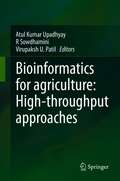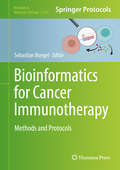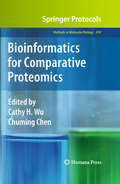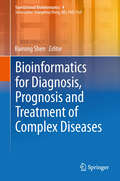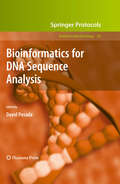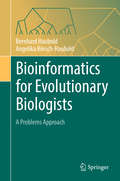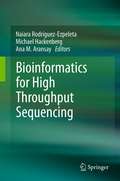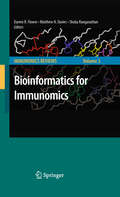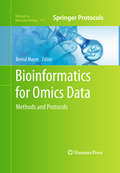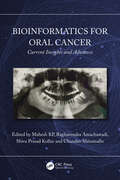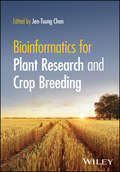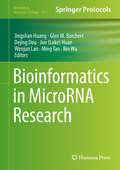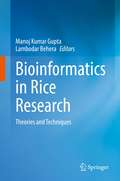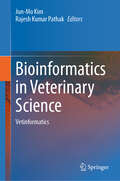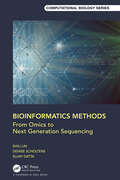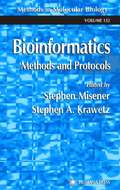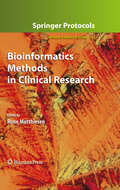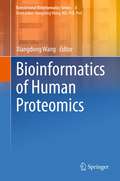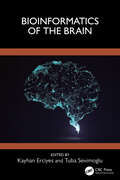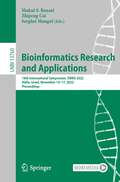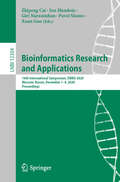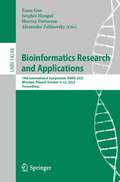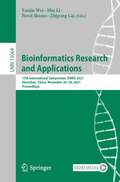- Table View
- List View
Bioinformatics for agriculture: High-throughput approaches
by Atul Kumar Upadhyay R Sowdhamini Virupaksh U. PatilThis book illustrates the importance and significance of bioinformatics in the field of agriculture. It first introduces the basic concepts of bioinformatics, such as homologous sequence and gene function analyses, determination of protein structures, and discusses machine learning applications for an in-depth understanding of the desired genes and proteins based on commonly used bioinformatics software and tools, e.g. BLAST, molecular modelling, molecular-docking and simulations, protein-protein and domain-domain interactions. The book also describes recent advances in the high-throughput analysis of whole genome and transcriptome using next-generation sequencing platforms, and functional proteome studies. It also examines the role of computational biology in understanding and improving the nutrient quality and yield of crops. Lastly, the book explores a comprehensive list of applications of bioinformatics to improve plant yield, biomass, and health, and the challenges involved.
Bioinformatics for Cancer Immunotherapy: Methods and Protocols (Methods in Molecular Biology #2120)
by Sebastian BoegelThis volume focuses on a variety of in silico protocols of the latest bioinformatics tools and computational pipelines developed for neo-antigen identification and immune cell analysis from high-throughput sequencing data for cancer immunotherapy. The chapters in this book cover topics that discuss the two emerging concepts in recognition of tumor cells using endogenous T cells: cancer vaccines against neo-antigens presented on HLA class I and II alleles, and checkpoint inhibitors. Written in the highly successful Methods in Molecular Biology series format, chapters include introductions to their respective topics, lists of the necessary materials and reagents, step-by-step, readily reproducible laboratory protocols, and tips on troubleshooting and avoiding known pitfalls.Cutting-edge and authoritative, Bioinformatics for Cancer Immunotherapy: Methods and Protocols is a valuable research tool for any scientist and researcher interested in learning more about this exciting and developing field.
Bioinformatics for Comparative Proteomics (Methods in Molecular Biology #694)
by Cathy H. Wu Chuming ChenWith the rapid development of proteomic technologies in the life sciences and in clinical applications, many bioinformatics methodologies, databases, and software tools have been developed to support comparative proteomics study. In Bioinformatics for Comparative Proteomics, experts in the field highlight the current status, challenges, open problems, and future trends for developing bioinformatics tools and resources for comparative proteomics research in order to deliver a definitive reference providing both the breadth and depth needed on the subject. Structured in three major sections, this detailed volume covers basic bioinformatics frameworks relating to comparative proteomics, bioinformatics databases and tools for proteomics data analysis, and integrated bioinformatics systems and approaches for studying comparative proteomics in the systems biology context. Written for the highly successful Methods in Molecular BiologyTM series, the contributions in this book provide the meticulous, step-by-step description and implementation advice that is crucial for getting optimal results in the lab. Comprehensive and easy-to-use, Bioinformatics for Comparative Proteomics serves all readers who wish to learn about state-of-the-art bioinformatics databases and tools, novel computational methods and future trends in proteomics data analysis, and comparative proteomics in systems biology.
Bioinformatics for Diagnosis, Prognosis and Treatment of Complex Diseases (Translational Bioinformatics #4)
by Bairong ShenThe book introduces the bioinformatics tools, databases and strategies for the translational research, focuses on the biomarker discovery based on integrative data analysis and systems biological network reconstruction. With the coming of personal genomics era, the biomedical data will be accumulated fast and then it will become reality for the personalized and accurate diagnosis, prognosis and treatment of complex diseases. The book covers both state of the art of bioinformatics methodologies and the examples for the identification of simple or network biomarkers. In addition, bioinformatics software tools and scripts are provided to the practical application in the study of complex diseases. The present state, the future challenges and perspectives were discussed. The book is written for biologists, biomedical informatics scientists and clinicians, etc. Dr. Bairong Shen is Professor and Director of Center for Systems Biology, Soochow University; he is also Director of Taicang Center for Translational Bioinformatics.
Bioinformatics for DNA Sequence Analysis (Methods in Molecular Biology #537)
by David PosadaThe storage, processing, description, transmission, connection, and analysis of the waves of new genomic data have made bioinformatics skills essential for scientists working with DNA sequences. In Bioinformatics for DNA Sequence Analysis, experts in the field provide practical guidance and troubleshooting advice for the computational analysis of DNA sequences, covering a range of issues and methods that unveil the multitude of applications and the vital relevance that the use of bioinformatics has today. Individual book chapters explore the use of specific bioinformatic tools, accompanied by practical examples, a discussion on the interpretation of results, and specific comments on strengths and limitations of the methods and tools. As a part of the highly successful Methods in Molecular BiologyTM series, this work provides the kind of detailed description and implementation advice that is crucial for getting optimal results. Focused and cutting-edge, Bioinformatics for DNA Sequence Analysis serves molecular biologists, geneticists, and biochemists as an enriched task-oriented manual, offering step-by-step guidance for the analysis of DNA sequences in a simple but meaningful fashion.
Bioinformatics For Dummies
by Cedric Notredame Jean-Michel ClaverieWere you always curious about biology but were afraid to sit through long hours of dense reading? Did you like the subject when you were in high school but had other plans after you graduated? Now you can explore the human genome and analyze DNA without ever leaving your desktop!Bioinformatics For Dummies is packed with valuable information that introduces you to this exciting new discipline. This easy-to-follow guide leads you step by step through every bioinformatics task that can be done over the Internet. Forget long equations, computer-geek gibberish, and installing bulky programs that slow down your computer. You'll be amazed at all the things you can accomplish just by logging on and following these trusty directions. You get the tools you need to:Analyze all types of sequencesUse all types of databasesWork with DNA and protein sequencesConduct similarity searchesBuild a multiple sequence alignmentEdit and publish alignmentsVisualize protein 3-D structuresConstruct phylogenetic treesThis up-to-date second edition includes newly created and popular databases and Internet programs as well as multiple new genomes. It provides tips for using servers and places to seek resources to find out about what's going on in the bioinformatics world. Bioinformatics For Dummies will show you how to get the most out of your PC and the right Web tools so you'll be searching databases and analyzing sequences like a pro!
Bioinformatics for Evolutionary Biologists: A Problems Approach
by Bernhard Haubold Angelika Börsch-HauboldThis self-contained textbook covers fundamental aspects of sequence analysis in evolutionary biology, including sequence alignment, phylogeny reconstruction, and coalescent simulation. It addresses these aspects through a series of over 400 computer problems, ranging from elementary to research level to enable learning by doing. Students solve the problems in the same computational environment used for decades in science - the UNIX command line. This is available on all three major operating systems for PCs: Microsoft Windows, Mac-OSX, and Linux. To learn using this powerful system, students analyze sample sequence data by applying generic tools, bioinformatics software, and over 40 programs specifically written for this course. The solutions for all problems are included, making the book ideal for self-study. Problems are grouped into sections headed by an introduction and a list of new concepts and programs. By using practical computing to explore evolutionary concepts and sequence data, the book enables readers to tackle their own computational problems.
Bioinformatics for High Throughput Sequencing
by Ana M. Aransay Naiara Rodríguez-Ezpeleta Michael HackenbergNext generation sequencing is revolutionizing molecular biology. Owing to this new technology it is now possible to carry out a panoply of experiments at an unprecedented low cost and high speed. These go from sequencing whole genomes, transcriptomes and small non-coding RNAs to description of methylated regions, identification protein - DNA interaction sites and detection of structural variation. The generation of gigabases of sequence information for each of this huge bandwidth of applications in just a few days makes the development of bioinformatics applications for next generation sequencing data analysis as urgent as challenging.
Bioinformatics for Immunomics (Immunomics Reviews: #3)
by Shoba Ranganathan Matthew Davies Darren D.R. FlowerThe field of Immunomics has developed within the post-genomic era as a response to the massive amount of biological and immunological data now available to researchers. Immunomics crosses the disciplines of immunology, genomics, proteomics and computational biology and address some fundamental problems in biological and medical research. This book covers some of the rich sources of immunological data that are currently available and describes the various bioinformatics techniques that have been utilized to aid our understanding of the immune system. It also describes the nature of the self/non-self distinction that forms the basis of immunological theory and how computational modeling can help to clarify our understanding of how the immune system works. This is the fourth volume in a series that will be dedicated to publishing advances in immunomics particularly those focusing on systemic and integrative approaches in basic and clinical immunology, immunoinformatics, and immunologically relevant instrumentation and high-throughput screening methods.
Bioinformatics for Omics Data: Methods and Protocols (Methods in Molecular Biology #719)
by Bernd MayerPresenting an area of research that intersects with and integrates diverse disciplines, including molecular biology, applied informatics, and statistics, among others, Bioinformatics for Omics Data: Methods and Protocols collects contributions from expert researchers in order to provide practical guidelines to this complex study. Divided into three convenient sections, this detailed volume covers central analysis strategies, standardization and data-management guidelines, and fundamental statistics for analyzing Omics profiles, followed by a section on bioinformatics approaches for specific Omics tracks, spanning genome, transcriptome, proteome, and metabolome levels, as well as an assortment of examples of integrated Omics bioinformatics applications, complemented by case studies on biomarker and target identification in the context of human disease. Written in the highly successful Methods in Molecular BiologyTM series format, chapters contain introductions to their respective topics, lists of the necessary materials and reagents, step-by-step, readily reproducible laboratory protocols, and notes on troubleshooting and avoiding known pitfalls. Authoritative and accessible, Bioinformatics for Omics Data: Methods and Protocols serves as an ideal guide to scientists of all backgrounds and aims to convey the appropriate sense of fascination associated with this research field.
Bioinformatics for Oral Cancer: Current Insights and Advances
by Raghavendra Amachawadi Shiva Prasad Kollur Chandan Shivamallu Mahesh KpAmid the rising global concern of oral cancer, this book provides a compelling exploration of the intricate oral cavity, focused on shedding light on early diagnosis and addressing outdated paradigms, it delves into the persistent challenges of oral premalignant lesions. Tailored for both beginners and researchers, its six chapters encompass the spectrum of genome sequencing, diagnostic biomarkers, gene expression, and more. Discover a fusion of basic and clinical sciences, aiming to invigorate the study of bioinformatics and oral cancer, and ultimately improve survival rates.Bioinformatics for Oral Cancer: Current Insights and Advances serves as a comprehensive guide, offering a deep dive into the multifaceted landscape of oral cancer research and bioinformatics. Within its pages, readers will uncover a wealth of knowledge, starting with foundational chapters introducing bioinformatics and establishing the backdrop of oral cancer. The book then progresses into the realm of diagnostic biomarkers, revealing cutting-edge methodologies for their identification in the context of oral cancer. The book’s keen focus extends to gene expression profiles and the intricacies of gene sequencing in the context of oral cancer progression. By systematically unravelling these critical aspects, the book bridges the gap between basic and clinical sciences, equipping readers with a holistic understanding of bioinformatics’ pivotal role in enhancing our grasp of oral cancer’s complexities.By deciphering the enigmatic landscape of oral premalignant lesions, the book equips clinicians and researchers with tools to predict malignant potentials. Its meticulous exploration of gene expression profiles and sequencing promises to reshape early detection strategies, propelling the field towards improved diagnosis and treatment outcomes.
Bioinformatics for Plant Research and Crop Breeding
by Jen-Tsung ChenExplore and advance bioinformatics and systems biology tools for crop breeding programs in this practical resource for researchers Plant biology and crop breeding have produced an immense amount of data in recent years, from genomics to interactome and beyond. Bioinformatics tools, which aim at analyzing the vast quantities of data produced by biological research and processes, have developed at a rapid pace to meet the challenges of this vast data trove. The resulting field of bioinformatics and systems biology is producing increasingly rich and transformative research. Bioinformatics for Plant Research and Crop Breeding offers an overview of this field, its recent advances, and its wider applications. Drawing on a range of analytical and data-science tools, its foundation on an in-silico platform acquired multi-omics makes it indispensable for scientists and researchers alike. It promises to become ever more relevant as new techniques for generating and organizing data continue to transform the field. Bioinformatics for Plant Research and Crop Breeding readers will also find: A focus on emerging trends in plant science, sustainable agriculture, and global food security Detailed discussion of topics including plant diversity, plant stresses, nanotechnology in agriculture, and many othersApplications incorporating artificial intelligence, machine learning, deep learning and more Bioinformatics for Plant Research and Crop Breeding is ideal for researchers and scientists interested in the potential of OMICs, and bioinformatic tools to aid and develop crop improvement programs.
Bioinformatics for Systems Biology
by Stephen KrawetzThe biological sciences are now in the midst of a true life sciences revolution akin to what physics experienced just after the turn of the last century. We are now in a phase of unparalleled growth that is reflected by the amount of data generated from each experiment. At the time of this writing, the rate of data acquisition was approaching 2 terabytes over the course of 5 days with first pass analysis proceeding over the following 2-3 week period. This fundamental shift has provided unprecedented opportunities that for the first time afford us the ability, i.e., means, breadth, and depth of data, to truly address human biology at the systems level. This wealth of information from seemingly disparate datasets and its integration is being realized through bioinformatics. It is with this philosophy that the text Bioinformatics for Systems Biology was born. This revolution has spawned true personalized medicine that encompasses diagnostics and treatment through to cure. For the physical and computer scientist, this text provides an introduction to the basic biological principles governing a cell. This quickly moves from the fundamentals to exploring the underlying genetic processes. While providing a rudimentary and necessary overview for the life scientist, the physical and computer scientist will be apprised of various nuances within the field reflecting the reality of "wet-bench" science. For those in the life sciences, it is rapidly becoming appreciated that we are progressing from examining our favorite "pet" gene to the system. Statistics is now an essential component to understand the vast datasets and this is emphasized throughout the text. The majority of the text is devoted to the common ground that these groups share. It provides rich examples of tools, databases, and strategies to mine the databases to reveal novel insights. A host of examples of parsing the data into a series of overlays that use various presentation systems are reviewed. The goal is to provide a representation most comfortable to the user to enable the user to thoroughly explore the data. The text concludes with examples of how the systems information is used to inform personalized medicine in a true "bench to bedside" manner. Bioinformatics for Systems Biology bridges and unifies many disciplines. It presents the life scientist, computational biologist, and mathematician with a common framework. Only by linking the groups together may the true life sciences revolution move forward in the mostly uncharted and emerging field of Systems Biology.
Bioinformatics in MicroRNA Research (Methods in Molecular Biology #1617)
by Bin Wu Jingshan Huang Glen M. Borchert Dejing Dou Jun Luke Huan Wenjun Lan Ming TanThis thorough volume provides an in-depth introduction to and discussion of microRNAs (miRs) and their targets, miR functions, and computational techniques applied in miR research, thus serving the need for a comprehensive book focusing on miR target genes, miR regulation mechanisms, miR functions performed in various human diseases, and miR databases/knowledgebases. Without prior knowledge of the area of study, computational biologists, computer scientists, bioinformaticians, bench biologists, as well as clinical investigators will find it easy to follow the techniques in this collection. Written for the highly successful Methods in Molecular Biology series, chapters include the kind of detailed implementation advice that ensures successful results. Accessible and practical, Bioinformatics in MicroRNA Research functions as an ideal guide for researchers of all backgrounds to explore this vital area of study.
Bioinformatics in Rice Research: Theories and Techniques
by Manoj Kumar Gupta Lambodar BeheraThis book provides an up-to-date review of classic and advanced bioinformatics approaches and their utility in rice research. It summarizes databases and tools for analyzing DNA, proteins and gene expression profiles, mapping genetic variations, annotation of protein and RNA molecules, phylogenetic analysis, and pathway enrichment.In addition, it presents high-throughput technologies that are widely used to provide deep insights into the genetic architecture of important traits in the rice genome. The book subsequently discusses techniques for identifying RNA-protein, DNA-protein interactions, and molecular markers, including SNP and microsatellites, in the contexts of rice breeding and genetics.Lastly, it explores various tools that are used to identify and characterize non-coding RNA in rice and their potential role in rice research.
Bioinformatics in Veterinary Science: Vetinformatics
by Jun-Mo Kim Rajesh Kumar PathakThis book presents a compendium of advanced research and basic principles/approaches related to vetinformatics. All chapters have explored the role of basic methods of vetinformatics that may be very helpful for students and researchers studying/working in the area of veterinary and animal science and may also serve the purpose of textbook. The latest developments in the field are discussed, and basic concepts are introduced in a simple but comprehensive way to ensure that students/researchers are able to understand the more advanced study in the proposed field. It also provides a comprehensive list of resources used for RNAseq data analysis, metagenomics, GWAS, systems biology and multiomics integration, molecular docking, toxicity prediction, QSAR, molecular dynamics simulation, vaccine designing, and machine learning. This book serves as an invaluable resource for researchers, faculty, and students of veterinary and animal sciences for understanding modern approaches and the application of vetinformatics involved in livestock research. This also focuses to guide map and carry out studies and research in the field of vetinformatics.
Bioinformatics Methods: From Omics to Next Generation Sequencing (Chapman & Hall/CRC Computational Biology Series)
by Shili Lin Denise Scholtens Sujay DattaThe past three decades have witnessed an explosion of what is now referred to as high-dimensional `omics' data. Bioinformatics Methods: From Omics to Next Generation Sequencing describes the statistical methods and analytic frameworks that are best equipped to interpret these complex data and how they apply to health-related research. Covering the technologies that generate data, subtleties of various data types, and statistical underpinnings of methods, this book identifies a suite of potential analytic tools, and highlights commonalities among statistical methods that have been developed. An ideal reference for biostatisticians and data analysts that work in collaboration with scientists and clinical investigators looking to ensure rigorous application of available methodologies. Key Features: Survey of a variety of omics data types and their unique features Summary of statistical underpinnings for widely used omics data analysis methods Description of software resources for performing omics data analyses
Bioinformatics Methods and Protocols (Methods in Molecular Biology #132)
by Stephen A. Krawetz Stephen MisenerHands-on users and experts survey the key biological software packages, offering useful tips and an overview of current developments. Among the sequence analysis systems reviewed are GCG, Omiga, MacVector, DNASTAR, PepToolTM, GeneToolTM, and the Staden Package. Molecular biology software includes Genotator and sequence-similarity searching using FASTA, CLUSTAL multiple sequence alignment, and phylogenetic analysis. Web-based resources are examined for primary sequence databases, primary sequence analysis methods, and clinical databases useful in molecular medicine. Numerous illustrative examples to teach the reader how to solve problems are included. Bioinformatics: Methods and Protocols constitutes a gold-standard reference for today's scientists who wish to develop and hone their bioinformatics skills towards the discovery of new biological relationships.
Bioinformatics Methods in Clinical Research (Methods in Molecular Biology #593)
by Rune MatthiesenIntegrated bioinformatics solutions have become increasingly valuable in past years, as technological advances have allowed researchers to consider the potential of omics for clinical diagnosis, prognosis, and therapeutic purposes, and as the costs of such techniques have begun to lessen. In Bioinformatics Methods in Clinical Research, experts examine the latest developments impacting clinical omics, and describe in great detail the algorithms that are currently used in publicly available software tools. Chapters discuss statistics, algorithms, automated methods of data retrieval, and experimental consideration in genomics, transcriptomics, proteomics, and metabolomics. Composed in the highly successful Methods in Molecular BiologyTM series format, each chapter contains a brief introduction, provides practical examples illustrating methods, results, and conclusions from data mining strategies wherever possible, and includes a Notes section which shares tips on troubleshooting and avoiding known pitfalls. Informative and ground-breaking, Bioinformatics Methods in Clinical Research establishes a much-needed bridge between theory and practice, making it an indispensable resource for bioinformatics researchers.
Bioinformatics of Human Proteomics (Translational Bioinformatics #3)
by Xiangdong Wang"Bioinformatics of Human Proteomics" discusses the development of methods, techniques and applications in the field of protein bioinformatics, an important direction in bioinformatics. It collects contributions from expert researchers in order to provide a practical guide to this complex field of study. The book covers the protein interaction network, drug discovery and development, the relationship between translational medicine and bioinformatics, and advances in proteomic methods, while also demonstrating important bioinformatics tools and methods available today for protein analysis, interpretation and predication. It is intended for experts or senior researchers in the fields of clinical research-related biostatistics, bioinformatics, computational biology, medicine, statistics, system biology, molecular diagnostics, biomarkers, or drug discovery and development. Dr.Xiangdong Wang works as a distinguished professor of Respiratory Medicine at Fudan University, Shanghai, China. He serves as Director of Biomedical Research Center, Fudan University Zhongshan Hospital and adjunct professor of Clinical Bioinformatics at Lund University, Sweden. His main research is focused on the role of clinical bioinformatics in the development of disease-specific biomarkers and dynamic network biomarkers, the molecular mechanism of organ dysfunction and potential therapies.
Bioinformatics of the Brain
by Kayhan Erciyes Tuba SevimogluThe brain consisting of billions of neurons is probably the most complex and mysterious organ of the body. Understanding the functioning of the brain in its health and disease states has baffled the researchers working in this area for many years. The diversity of brain diseases and disorders makes the analysis of brain functions an even more challenging area of research. In vitro and in vivo studies regarding the brain may be laborious, however, bioinformatics using in silico approaches may take the burden off the experimental studies and give us a clearer perspective on disease and healthy states of the brain, its functions, and disease mechanisms.Recent advancements in neuroimaging technologies, the development of high-performance computers and the development of software, algorithms and methods to analyze data obtained from various neuroimaging processes have opened new frontiers in neuroscience enabling unprecedented finer analysis of the brain functions. This relatively new approach of brain analysis which may be termed Bioinformatics of the Brain is the main subject of this volume aiming to provide a thorough review of various bioinformatics approaches for analyzing the functioning of the brain and understanding brain diseases such as neurodegenerative diseases, brain tumors, and neuropsychiatric disorders. Authors from various disciplines in this volume each focus on a different aspect aiming to expand our understanding of this area of research. Topics included are: Brain diseases and disorders Stem cell therapy of neurodegenerative diseases Tissue engineering applications of gliomas Brain tumor detection and modeling Brain tumor growth simulation Brain-computer interface Bioinformatics of brain diseases Graph-theoretical analysis of complex brain networks Brain proteomics This book is intended to aid scientists, researchers, and graduate students in carrying out interdisciplinary research in the areas of bioinformatics, bioengineering, computer engineering, software engineering, mathematics, molecular biology, genetics, and biotechnology.
Bioinformatics Research and Applications: 18th International Symposium, ISBRA 2022, Haifa, Israel, November 14–17, 2022, Proceedings (Lecture Notes in Computer Science #13760)
by Mukul S. Bansal Zhipeng Cai Serghei MangulThis book constitutes the proceedings of the 18th International Symposium on Bioinformatics Research and Applications, ISBRA 2022, held in Haifa, Israel, in November 14–17, 2022.The 30 full papers and 4 short papers presented in this book were carefully reviewed and selected from 72 submissions. They were organized in topical sections named: AI and disease; computational proteomics; biomedical imaging; drug screening and drug-drug interaction prediction; Biomedical data; sequencing data analysis.
Bioinformatics Research and Applications: 16th International Symposium, ISBRA 2020, Moscow, Russia, December 1–4, 2020, Proceedings (Lecture Notes in Computer Science #12304)
by Zhipeng Cai Ion Mandoiu Giri Narasimhan Pavel Skums Xuan GuoThis book constitutes the proceedings of the 16th International Symposium on Bioinformatics Research and Applications, ISBRA 2020, held in Moscow, Russia, in December 2020. The 23 full papers and 18 short papers presented in this book were carefully reviewed and selected from 131 submissions. They were organized in topical sections named: genome analysis; systems biology; computational proteomics; machine and deep learning; and data analysis and methodology.
Bioinformatics Research and Applications: 19th International Symposium, ISBRA 2023, Wrocław, Poland, October 9–12, 2023, Proceedings (Lecture Notes in Computer Science #14248)
by Xuan Guo Serghei Mangul Murray Patterson Alexander ZelikovskyThis book constitutes the refereed proceedings of the 19th International Symposium on Bioinformatics Research and Applications, ISBRA 2023, held in Wrocław, Poland, during October 9–12, 2023.The 28 full papers and 16 short papers included in this book were carefully reviewed and selected from 89 submissions. They were organized in topical sections as follows: reconciling inconsistent molecular structures from biochemical databases; radiology report generation via visual recalibration and context gating-aware; sequence-based nanobody-antigen binding prediction; and hist2Vec: kernel-based embeddings for biological sequence classification.
Bioinformatics Research and Applications: 17th International Symposium, ISBRA 2021, Shenzhen, China, November 26–28, 2021, Proceedings (Lecture Notes in Computer Science #13064)
by Yanjie Wei Min Li Pavel Skums Zhipeng CaiThis book constitutes the proceedings of the 17th International Symposium on Bioinformatics Research and Applications, ISBRA 2021, held in Shenzhen, China, in November 2021. The 51 full papers presented in this book were carefully reviewed and selected from 135 submissions. They were organized in topical sections named: AI and disease; computational proteomics; biomedical imaging; drug screening and drug-drug interaction prediction; Biomedical data; sequencing data analysis.
